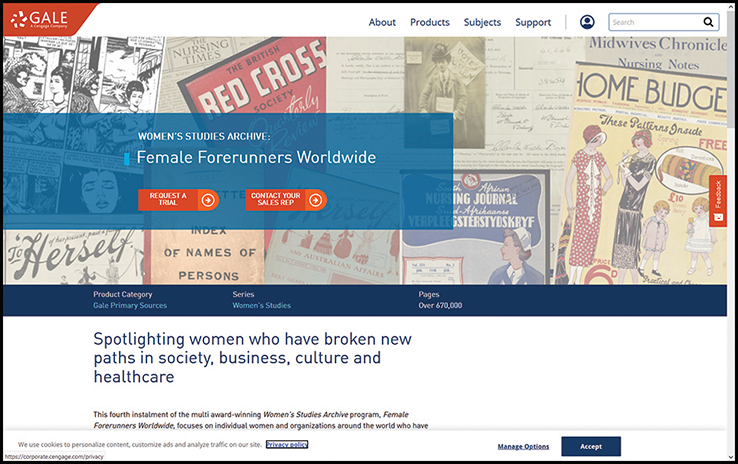LJ’s Top 10 Picks for Best Databases 2022
LJ’s top 10 picks for Best Reference Databases 2022 range in scope from architecture to history to women trailblazers.
From history to crafts, these sites expand the possibilities of research for students, general readers, and scholars. Do not miss our 2022 selections of Best Print Reference Works and Best Free Resources.
Bloomsbury Architecture Library. Bloomsbury.
Two robust collections combine excellently in this reference. The first, the Core Collection, features 113 architecture ebooks, 2,200 images and building plans, and an interactive time line and architectural world map. The second, Architecture Design & Practice Online, offers more than 200 ebooks on studio design, technical drawings, case studies, and more. Content is accessible through intuitive navigational options that allow users to browse or conduct targeted searches.

Bloomsbury History: Theory & Method. Bloomsbury.
Designed for students and researchers, this comprehensive resource focuses on history theory, method, and historiography. Curated and developed by an international team of scholars from 29 countries across five continents, content includes 100-plus exclusive articles, a four-volume collection of critical readings on historiography, and more than 60 scholarly books from Bloomsbury’s catalogue. The beautifully designed platform enables intuitive browsing and the ability to easily and quickly drill into content.
Creativebug. Creativebug.
Exactly what fans of crafting classes and Skillshare tutorials have been waiting for, this outstanding resource fills a critical gap in the library-learning space. Users can access thousands of classes on art, crafting, and other forms of artistic expression via a wide range of subjects, including art and design, sewing, quilting, jewelry, and more. Tutorials include beginners’ courses, multipart and quick selections, and Creativebug Live classes.
Declassified Documents Online: 20th-Century British Intelligence; Monitoring the World. Gale.
A must for researchers of World War I, World War II, or the Cold War, this database provides unprecedented access to UK documents on British intelligence activities in the 20th century. This recent addition to Gale’s Declassified Documents Online contains manuscripts from Government Communications Headquarters, the Central Intelligence Agency, the Joint Intelligence Committee, and more. This essential and highly searchable database is enhanced by Gale’s helpful suite of research tools.
Ethnic Diversity Source. EBSCO.
This vital addition to diversity and ethnic studies offers 5,400-plus ebooks, 2,200 full-text biographies, and tens of thousands of primary documents and curated videos dedicated to coverage of the culture and lived experiences of Black, Arab, Jewish, Latinx, Indigenous, and Asian Americans. Users will be aided by EBSCO’s powerful search functionalities, allowing them to conduct precise searches and access millions of photographs, books, and articles.
The Gilded Age and Progressive Era. AM.
Spanning the years between 1870 and 1920, AM’s (formerly known as Adam Matthew) expansive collection of primary sources focuses on one of the most critical and transformative eras in American history. Researchers can explore the papers of key industrialists; visuals on fashion, material culture, and architecture; plus calendars, cartoons, ephemera, personal correspondence, and more, all drawn from eight renowned archives and libraries, including the Library of Congress, the New-York Historical Society, and Yale’s Beinecke Rare Book & Manuscript Library.
Mass Observation Project, Module III. AM.
This most recent update to AM’s groundbreaking Mass Observation Project introduces data from the period of 2000 to 2009, allowing unprecedented access to original manuscript and typescript papers created and collected through the University of Sussex’s comprehensive survey of the lived experience of the British public. With the aid of essays, videos, and an interactive time line, searchers can explore a broad range of themes, including the Great Recession, the swine flu outbreak, environmental issues, and the terrorist attacks of September 11.
ProQuest Black Studies. ProQuest.
Drawing from full-text scholarly journals and magazines, Black historical newspapers, dissertations, and more, this groundbreaking resource supports research and learning through in-depth primary source materials. Hundreds of streaming videos and images accompany the texts, presenting an engaging, multilayered learning experience. The user-friendly interface mines full text and bibliographic records of documents, making it possible for users to search and cross-reference easily. An authoritative product for academic researchers and students alike.
Statista. Statista.
Statista provides access to comprehensive statistical data with an emphasis on market research and analysis. Statista’s expert tools, including Consumer Insights, eCommerce Insights, and Company Insights, feature a wealth of data referencing thousands of brands, tens of thousands of marketplaces, and hundreds of countries across the world. Response time is fast, and charts and graphics enhance the user experience.

Women’s Studies Archive: Female Forerunners Worldwide. Gale.
This primary-source archive focuses on women trailblazers in pop culture, business, activism, and more. Materials span from 1759 to 2002 and are sourced from institutions such as the Smithsonian; the Library of Congress; the Gay, Lesbian, Bisexual, Transgender (GLBT) Historical Society; and the Schomburg Center for Research in Black Culture. The Earl Conrad/Harriet Tubman Collection and several more particularly highlight the voices of those who were enslaved or imprisoned.
RELATED
ALREADY A SUBSCRIBER? LOG IN
We are currently offering this content for free. Sign up now to activate your personal profile, where you can save articles for future viewing









Add Comment :-
Comment Policy:
Comment should not be empty !!!